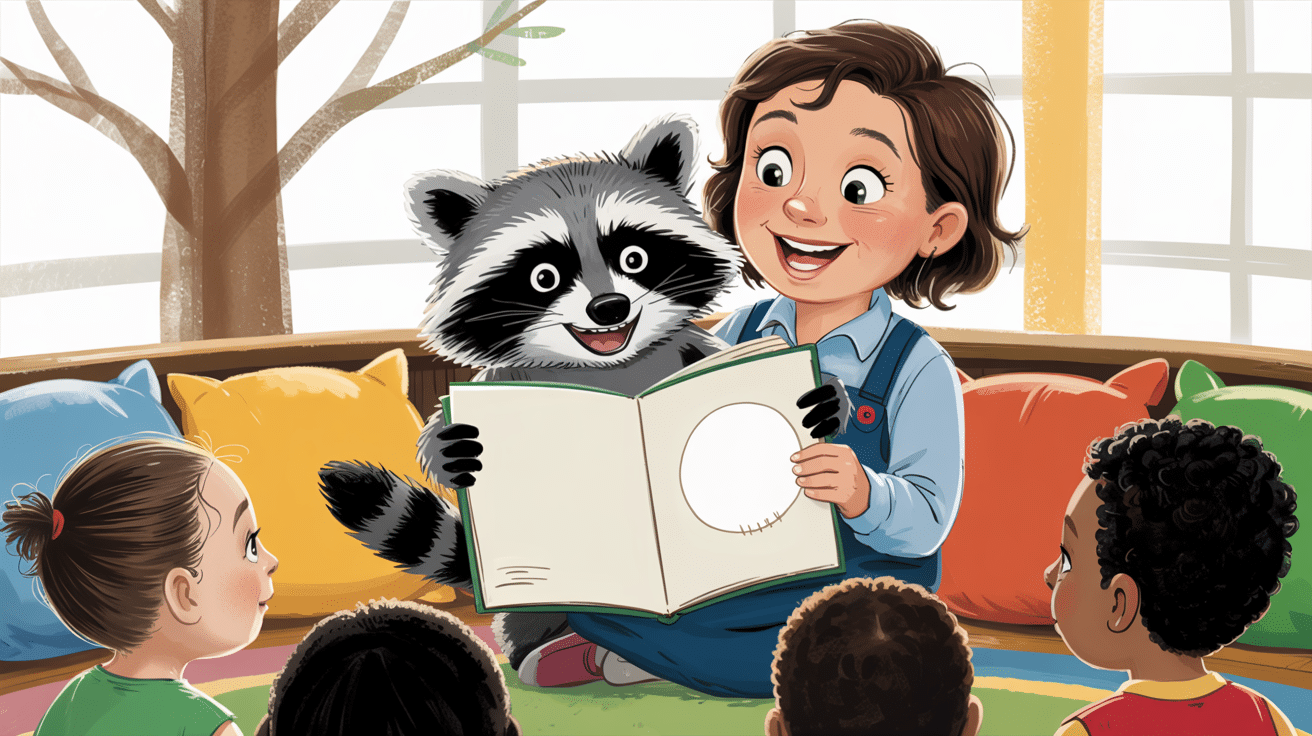Do you see those little faces full of worry on the first day of preschool? Many children feel scared when they have to leave their parents. They need something special to help them feel safe and loved.
The Kissing Hand story offers a simple way to ease this fear. It shows how a small gesture – a kiss on the hand – can help children feel connected to family even when apart.
With these Kissing Hand activities, teachers and parents can help young ones learn important skills. These fun tasks build reading abilities, boost social growth, and help kids understand their feelings.
By the end of this blog post, you’ll have easy-to-use activities that make learning fun. Your preschoolers will gain confidence while playing and creating. Let’s look at how the Kissing Hand activities for preschool can make a big difference for your little ones!
Why Is The Kissing Hand Story Important for Preschoolers?

“The Kissing Hand” tells the story of Chester Raccoon, who is nervous about starting school. His mother kisses his palm and tells him that whenever he feels lonely, he can press his hand to his cheek to feel her love. This simple story helps many young children cope with separation.
- Builds emotional security: Children learn they can feel safe even when away from parents, which is key for growth.
- Teaches coping skills: Kids gain tools to handle their fears and worries in new settings.
- Helps with transitions: The story makes the shift to school less scary through a caring ritual.
- Creates connection: Children understand that love remains strong even during separation.
- Promotes literacy: The tale offers a way to talk about feelings while building reading skills.
The Kissing Hand activities for preschool help teachers bring these lessons to life. By using these ideas, you can create a warm, caring space where young learners feel both safe and ready to grow.
Buy the book here:The Kissing Hand
Disclaimer: The products mentioned below are based solely on personal experience and are not sponsored or affiliated with any brands.
Materials Needed for The Kissing Hand Activities for Preschool
| Activity | Basic Materials | Optional Extras |
|---|---|---|
| Handprint Memory Book | Construction paper, washable paint, binding materials (yarn or staples) | Photos, stickers, crayons |
| Feelings Chart with Hands | Colored paper, markers, poster board | Laminating sheets, Velcro dots |
| Raccoon Puppet Making | Paper bags, gray construction paper, googly eyes, glue | Markers, scissors, black paper |
| Kiss Counting Game | Paper, heart stickers, number cards | Laminating sheets, dry-erase markers |
| Sensory Hand Tracing | Cardstock, glue, and a variety of textured materials | Display tape, scissors, markers |
| Family Hand Garland | Colored paper, scissors, tape, or staples | String, hole punch, decorations |
| Kiss Pocket Craft | Felt or heavy paper, string, scissors | Sequins, fabric scraps, glue |
| Emotion Rocks | Smooth rocks, acrylic paint, clear varnish | Paintbrushes, small cloth bag |
| Kissing Hand Book Box | Small boxes, construction paper, and glue | Photos, decorative items |
| Memory Matching Game | Cardstock, scissors, markers, or printed images | Container for storage, laminating sheets |
| Love Notes Jar | Small plastic jars, tissue paper, and glue | Ribbon, decorative tape, paper strips |
Having these materials ready before starting The Kissing Hand activities for preschool will help your sessions run smoothly and allow children to focus on learning and having fun.
The Kissing Hand Activities for Preschool Learning: Interactive Ideas

These The Kissing Hand activities for preschool offer fun ways to help children feel secure while building important skills through play and creativity:
1. Handprint Memory Book
Children create a special book with their handprints to remember their friends and teachers. This keepsake helps them feel connected to school even when they’re at home, making the transition easier for everyone.
Instructions:
- Give each child colored construction paper and washable paint
- Help them make handprints on each page
- Add photos, names, or small notes from classmates
- Bind pages together with yarn or staples
- Let children decorate their covers with crayons and stickers
2. Feelings Chart with Hands
Students learn to identify and express their emotions using hand-shaped cutouts. This visual tool helps young children put names to their feelings and understand that all emotions are normal.
Instructions:
- Cut out paper hands in different colors
- Draw various facial expressions on each hand
- Attach hands to a poster board with emotions labeled
- Ask children to point to hands that match their feelings
- Talk about why they might feel that way
3. Raccoon Puppet Making
Kids craft their own Chester Raccoon puppets to act out the story. This hands-on project helps them process the story’s message while working on fine motor skills.
Instructions:
- Provide paper bags, googly eyes, and gray construction paper
- Cut ear shapes and tails from gray paper
- Glue parts onto paper bags to create raccoons
- Draw faces with markers
- Use puppets to retell the story in pairs
4. Kiss Counting Game
Children practice counting skills with a math activity based on the story. This game makes numbers fun while reinforcing the comforting theme from the book.
Instructions:
- Draw hand outlines on paper
- Place different numbers of kiss stickers on each hand
- Ask children to count the kisses
- Match hands with the correct number cards
- Take turns adding or removing kisses to change the numbers
5. Sensory Hand Tracing
Students trace their hands and fill them with different textures. This sensory experience helps them connect with their sense of touch while creating a personal reminder of the story.
Instructions:
- Trace each child’s hand on cardstock
- Provide materials like cotton balls, sandpaper, and fabric
- Help children glue different textures inside their hand outline
- Talk about how each texture feels
- Display hands on a wall titled “Our Feeling Hands”
6. Family Hand Garland
Families trace and cut out all family members’ hands to create a connected chain. This take-home project strengthens the bond between school and home, giving children a visual reminder of their connections.
Instructions:
- Send home colored paper and simple instructions
- Ask families to trace everyone’s hands
- Cut out the hand shapes
- Connect them with tape or staples to form a chain
- Hang the garland where the child can see it daily
7. Kiss Pocket Craft
Children create small pockets to carry “kisses” from home. This simple craft gives them a concrete way to feel connected to family throughout the school day.
Instructions:
- Cut small pocket shapes from felt or paper
- Decorate with markers, sequins, or stickers
- Attach a string to wear around the neck
- Parents place paper hearts with messages inside
- Children can reach for a “kiss” when missing home
8. Emotion Rocks
Students paint small rocks with faces showing different feelings. These portable tools help them identify and talk about emotions while giving them something tangible to hold.
Instructions:
- Collect smooth, flat rocks
- Clean and dry completely
- Paint with acrylic paints in skin tones
- Add facial features showing various emotions
- Seal with clear varnish when dry
- Keep in a small bag for children to use
9. Kissing Hand Book Box
Kids decorate storage boxes to keep special items from home. This container creates a safe space for valuables that helps them feel connected to family while at school.
Instructions:
- Provide small shoe boxes or plastic containers
- Cover with construction paper
- Decorate with handprints using paint
- Add photos or drawings of family members
- Store small comfort items inside
10. Memory Matching Game
Children create and play a matching game with images from the story. This activity builds memory skills while reinforcing the characters and plot of the book.
Instructions:
- Cut cards from cardstock in equal sizes
- Draw or paste story images on cards (make pairs)
- Mix the cards and place them face down
- Take turns flipping two cards to find matches
- Talk about the story elements on the cards
11. Love Notes Jar
Students decorate jars to collect notes from family members. This ongoing activity creates a bridge between home and school, giving children access to family love throughout the day.
Instructions:
- Clean and dry small plastic jars
- Decorate with tissue paper and glue
- Send home paper strips for family messages
- Fill in notes before school
- Allow children to read a note when they need comfort
These The Kissing Hand activities for preschool help build bridges between home and school, giving children the emotional tools they need to feel secure and ready to learn.
Bringing The Kissing Hand to Life: Interactive Storytelling Tips

These storytelling techniques will enhance The Kissing Hand activities for preschool by making the book come alive for young listeners.
- Use different voices for characters: Change your tone when speaking as Chester or his mother. This helps children follow the story and makes the characters feel real to them.
- Add simple props to story time: Hold up a stuffed raccoon or create a tree backdrop with paper. Visual aids help kids connect with the story and keep their attention throughout the reading.
- Invite movement during key moments: Ask children to place their hands on their cheeks when Chester does in the story. This physical involvement helps them understand the meaning behind the kissing hand gesture.
- Ask open-ended questions while reading: Pause to ask “How do you think Chester feels now?” or “What would you do if you were scared?” This builds thinking skills and personal connections to the story.
- Create a cozy reading space: Arrange cushions in a circle or use a special storytelling chair. A comfortable environment helps children focus on the story and feel safe discussing their own feelings after reading.
Incorporating these interactive storytelling methods into The Kissing Hand activities for preschool creates meaningful learning experiences that children will remember long after story time ends.
The Bottom Line
Starting school brings big feelings for little ones. These activities help turn worries into smiles. When children press their hands to their cheeks, they feel the love that stays with them all day.
The Kissing Hand activities for preschool do more than just ease fears. They build reading skills, boost number sense, and help kids talk about their feelings. Each craft, game, and story time creates a bridge between home and school.
Remember that each child learns at their own pace. Some might need extra hugs, while others jump right in. The most important thing is making them feel safe and loved.
What methods do you use to help children feel secure in your classroom? Share your ideas in the comments below- your tips might help another teacher or parent!




